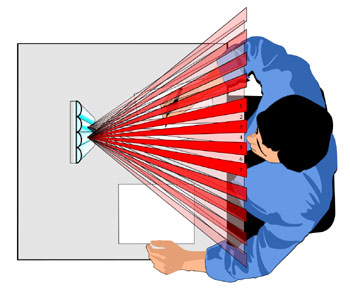I understand that you do not need to wear the glasses to utilize the new monitors. What I am resistant to is finding glasses for my family on movie night, seven of us total, with how many extra friends floating around: "Matt, where are your glasses? I don't know Dad, I put them down over there last time...I'll just use yours..." I think you get this point.
Wouldn't you prefer a solution like this? Not saying it is the best, but at least it's a start in the right direction:
http://www.pcworld.com/article/190937/3d_imageswithout_glasses.html
OH MY GOD, NO, I don't want that solution. I've tried it... saw that display in person. I hear you about not wanting the hassle of glasses, but it's not going to happen.
So why does that screen look cool at a trade show and not work at home? Simple optics. You'll see the right image only if you're in one of the "64 positions" they mention in the newscast you linked to. and if you stay completely motionless. And if your head is perfectly vertical. If you shift your body just SLIGHTLY (3-4 inches is enough from some seating distances!) to the left or right, then the wrong eye gets each image. you see the REVERSE 3-D effect, which is horrible.
Think about it... somehow one discrete image needs to reach each viewer's LEFT eye, a separate one needs to reach each RIGHT eye. Blasting the images in "stripes" radiating out from the screen (like thick alternating spokes from a bike wheel) can work only in VERY unrealistic setups... each person finds one of the sweet spots and remains
perfectly still. their left eye is in one of the "pie wedges" radiating out from the screen for that image, and same for right eye. move even slightly, and you get a blur or the reverse images. The issue is that the screen is just radiating out LEFT slices and RIGHT slices and of course has no idea whose head is where. How can it control which eye is currently sitting in a slice for each wedge? It can't of course. So some viewers get the inverse image, some get a blended/blurry image, and a very few, sitting perfectly still, will see the right image.
Remember those 3-D kids books? the pictures had this rough surface if you moved your finger across it? same basic technology (Lenticular Autostereoscopy), little prisms sending out one image in lots of little slices, interspersed with the other image in alternating slices. Your brain can make sense of it, but remember how the image shimmered if you moved your head or the book left and right? This is a necessary evil, your eyes are moving across the "right" and "wrong" slices.
But it worked for a static image, primarily because it had the advantage, since it was a book and would be held in the hands, that the designers could design the lenticules knowing the typical viewing distance of about 18 inches or so. move too close, and the effect goes away, move further away, same thing. Can't really do that well when you assume multiple viewers at different viewing distances and positions. NOTE, that you WILL see laptop computers using this technology... since, like books, you can assume a relatively fixed viewing distance and typically straight-on viewing angle, (as in the picture above), but you WILL still get the shimmer effect moving left and right.
There's another technology choice for Autostereoscopy - called a
Parallax Barrier. Similar to Lenticular lenses... it blocks half the image from radiating in certain angles, the other half from alternating sliced angles, so that (ideally), one eye gets one image, the other gets the other image. The barrier can be physical (tiny light-blocking bars down the display) or done with LCD crystals... but the effect is similar.
So what are the problems here? Well, probably obvious by now... set viewing spots where it works, but far more other spots where it's blurry, distorted, or the 3-d image is even completely reversed. No ability to tilt your head and preserve the 3-D effect. So forget leaning your head at an angle on your partner, or laying down... anything other than perfect 90 degree straight up-and-down head position means NO 3-D, just a blurry mess. You can see this in the pictures above... notice the lenticles are cylindrical, aligned up and down and the Parallax Barriers are also aligned vertically.
If that's not bad enough, you may already have figured out one of the other problems with Lenticular and Parallax Barrier autostereoscopy... something the breathless mainstream media articles also fail to mention:
the horizontal resolution of your display is HALVED! Half the vertical columns of pixels are sending the left image, half are sending the right. So, you'll put up with 1/2 the detail/resolution! Starting to really want that display yet?

All those problems AND half resolution!
So, I want a no-glasses solution as much as you do, but unfortunately, the more you look into this and think about the problem with a flat 2D display trying to send out an image to one eye that's 2.5 inches away from the other eye, and doing this for multiple viewers at multiple angles and varying distances, you realize that the solution (for now) is to separate the images at each person's face, not at the display.
Your example about "Dad, I can't find my glasses" really rings true for me too. (albeit only 2 kids), but put in that display you're talking about and the experience becomes one of forcing those kids to sit in a specific spot with no movement at all, heads perfectly upright, or everyone quickly getting headaches and seeing blurriness. AND, those screens CAN'T do normal 2D without massive loss of resolution and detail. they have a lens that is distorting the image permanently. A real nightmare.
So until we have something like holodeck technology, we're forced into 3 choices:
- Active-shutter glasses
Disadvantages:
- geeky, expensive, battery-using glasses.
Advantages:
- Perfect 3-D images to each viewer, regardless of distance, viewing angle, or angle of head-tilt
- a screen that does perfect normal 1080p 240hz images 99% of the time when not in 3D mode.
- Passive polarized glasses
Disadvantages:
- Requires glasses (slightly less geeky/bulky)
- compromised 2D images unless polarized filter is physically movable,
- dimmer image,
- 3D performance may degrade with head-tilt positioning.
Advantages:
- cheaper-but-still-geeky glasses,
- no batteries or recharging.
- Autostereoscopic ("Glasses-Free") Displays
Disadvantages:
- Half the vertical resolution for all displays
- defined micro-sweet-spots for the right 3-D effect.
- viewers must remain perfectly straight, can't move left-or-right without 3-D effect shimmering and swapping between "proper" and "reverse 3D",
- dramatic loss of detail and performance for normal 1080p 2D content.
Advantages:
Disadvantages: Advantages: ??
Personally, I'll take #1... and rarely use 3D, but enjoy my outstanding 2D performing screen 99% of the time... and very rarely deciding to switch into 3D mode, but when I do, knowing each viewer is getting the full effect regardless of location or head angle.
Fun discussions, would like to hear what others think who have experienced the various technologies.






